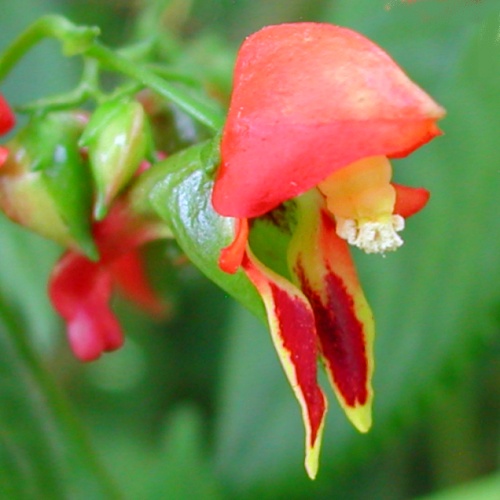| Home |
Strange Wonderful Things
Rare and exotic plants
|
 |
Impatiens sakeriana

Germinating the seeds
When to plant -- Plant your seeds when you receive them for best germination.
Getting started -- You may plant each seed in individual, small containers. Or you plant them all in a single
container, but it may be more difficult to transplant them later. Either way, use pots with drainage holes
For soil, use a well draining mix high in organic matter. A typical mix is 2 parts potting soil to 1 part
perlite (use small- or medium-size perlite, not large chunks) or
coarse sand. An alternate mix is 1 part perlite to 1 part
coco fiber, with some slow-release fertilizer
mixed in.
(use small- or medium-size perlite, not large chunks) or
coarse sand. An alternate mix is 1 part perlite to 1 part
coco fiber, with some slow-release fertilizer
mixed in.
Fill the pots with soil, place a seed or 2 on the surface, and gently
press it into the surface, making sure part of it is still exposed. If you
have long-fibered sphagnum moss (not ground peat moss), sprinkle some on the
surface. This helps retain moisture around the seeds while allowing light
to reach them, which aids germination.
This photo shows how much moss to use.
If you don't have the moss, sprinkle some of your soil mix around the seeds. Add water until everything is evenly moist (but not soggy).
Until the seeds sprout, ensure that the surface soil always stays moist. A plastic dome or bag
is good for maintaining moisture, but leave it open a crack to allow some fresh air in. You may need to drip a few drops of water over the seeds every day to keep the seeds
moist.
The ideal temperature for germination is between 68 to 77 degrees F (20-24°C). A little cooler at night is ok.
Avoid letting them get above 80° F (26°C) for prolonged periods. I recommend placing a minimum/maximum thermometer near the pots,
especially if using a heating mat.
Place the pot in bright
light out of direct sun. A bright LED or fluorescent bulb kept 4 inches
(10 cm) away provides the right amount of light (See: "Growing indoors with LED lights").
They should start germinating within about 4 to 6 weeks, but may take a little
to longer to start.
Increase air ventilation slightly after sprouting to prevent rot, but continue keeping the
soil surface moist for 2-3 weeks after sprouting.
Growing onward...
Lighting -- This Impatiens prefers bright shade, or filtered sunlight. Avoid prolonged direct sun
while they are young, unless it's early-morning sun.
Fertilizing -- The first 8 weeks, feed weekly with a small amount of
dilute (1/8 strength) liquid fertilizer.
Hydroponic fertilizer
is ideal for young seedlings, since it is easily absorbed and contains all
essential nutrients. After 8 weeks, you may switch to a granular
fertilizer that contains micronutrients, feeding at half the dosage on the
package.
Transplanting -- When your plants are 2-3 months old, you may gently
transfer them to a larger pot. Water the soil first, and avoid letting the
soil ball break apart, which can damage the roots. After transplanting,
give no sun or liquid fertilizer the first week.
Watering -- Aim to keep the soil moist, but not soggy. Never let it dry
out completely. You may use a moisture meter probe to monitor the moisture levels down in the root zone.
Climate -- Impatiens sakerana comes from cool cloudforests with
temperatures in the 70s or slightly above (25-27°C). I have no information on
whether it can take hotter conditions, so consider it experimental in areas that regularly get above 85 degrees F (29°C), particularly if nights are warm (above 65°F / 18°C). It has handled winter lows in the mid-30s here (2°C), although i
don't think it can survive freezing temperatures.
Over about 40-45% humidity
seems to be best. If they seems to suffer from low humidity indoors,
consider using an ultrasonic humidifier, sold at home improvement stores and
some thrift shops.
Have fun growing them!
- Jeff
Strange Wonderful Things
| Home |
Strange Wonderful Things
Rare and exotic plants |

|
| Entire site Copyright 2003-2025 by Strange Wonderful Things, except as noted |
|


